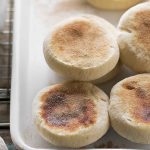Description
These Incredibly Soft Overnight Sourdough English Muffins are pillowy, tender discs with those perfect nooks and crannies, made simple with an overnight rise and active sourdough starter! You’ll love their chewy texture and tangy flavor, wonderful split and toasted with butter or your favorite spread!
Ingredients
For the English Muffins:
- 250 g (1 cup plus 1 teaspoon) milk, whole or 2 percent
- 120 g (½ cup) water
- 50 g (4 tablespoons) unsalted butter, cut into cubes
- 75 g (heaped ⅓ cup) active sourdough starter, bubbly and ready
- 25 g (2 tablespoons) sugar
- 500 g (4 cups plus 2 tablespoons) all purpose flour
- 10 g (1 ½ teaspoons) fine sea salt
- Cornmeal or semolina flour, for dusting the surface
Instructions
Prepare the Dough
- Warm the milk, water, and butter together in a small pot on the stove. Heat gently until the butter melts and the mixture is just warm, not hot. Allow this warm liquid to cool slightly before you add it to the other ingredients.
- Get a large mixing bowl. Put the active sourdough starter and the sugar into this bowl. Pour the cooled, warm milk mixture over the starter and sugar. Whisk these together briefly to combine everything.
- Add the all purpose flour and the fine sea salt to the bowl. Use a fork initially to mix everything until a shaggy dough begins to form. Finish bringing the dough together by hand, ensuring all the dry flour is worked into the wet ingredients.
- Cover the bowl containing the dough with a damp cloth. Let the dough rest at room temperature for about 30 minutes.
First Rise (Bulk Fermentation)
- After the 30 minute rest, uncover the dough. Work it gently within the bowl to form it into a relatively smooth ball.
- Lightly oil a piece of plastic wrap. Cover the bowl with the oiled plastic wrap. This helps prevent the dough from sticking as it rises.
- Let the dough rise at room temperature. Aim for a room temperature around 70 degrees F (21 degrees C). The dough needs to double in size. This will take about 8 to 10 hours, possibly longer depending on your starter and room temperature. Once the dough has doubled in size, place the covered bowl in the refrigerator to chill overnight.
Shape the Dough
- The next morning, take the cold dough out of the refrigerator. Transfer it onto a surface dusted with flour. Let the cold dough rest for about 10 minutes.
- Line a baking sheet with parchment paper. Sprinkle this paper generously with cornmeal or semolina flour to stop the English muffins from sticking.
- Lightly flour your hands. Gently pat the dough into a rectangular shape about 1/2 inch thick (approximately 1.25 centimeters).
- Cut out 10 to 12 rounds from the dough rectangle. You can use the rim of a drinking glass, a large jar, or a biscuit cutter that is 3 to 5 inches wide. Carefully place the cut dough rounds onto the prepared baking sheet. Sprinkle the tops of the rounds with more cornmeal.
Second Rise
- Cover the shaped English muffins on the baking sheet. You can use a damp kitchen towel or invert a second rimmed baking sheet over the first one.
- Let the covered rounds rest at room temperature. They should become noticeably puffy. This second rise usually takes about 1 hour or maybe longer, again depending on how warm your room is.
Cook the Muffins
- Get a large, non-stick skillet and place it on your stove. Warm the skillet over low heat. It’s important the heat is low and even.
- Do a test run with just one English muffin round first. Place one round into the warm skillet. Cover the skillet with a lid.
- Cook the single muffin on one side for 8 to 10 minutes. Check it halfway through the cooking time to see how it is browning. If it’s browning too fast, reduce the heat slightly.
- Flip the dough round over. Cover the skillet again and cook the second side for another 8 to 10 minutes.
- Once you’ve found the right heat setting with your test muffin, cook the remaining English muffins in batches. They are done when they feel light when you lift them and the sides spring back gently if you press them.
Notes
Heat Control: Achieving the perfect cook on English muffins depends on balanced, low heat. If your skillet is too hot, the outsides will brown too quickly, leaving the inside of the muffin undercooked.
Oven Finish: If you find your muffins are browning on the outside but are still raw inside, don’t worry. You can finish cooking them in a low temperature oven. A temperature around 250 degrees F (130 degrees C) works well until they are cooked all the way through.
Test Batch Advantage: It’s highly recommended to cook just one muffin first. This test batch lets you check your skillet temperature and adjust it before you cook the rest of your dough rounds. Getting the heat right ensures evenly cooked, delicious English muffins.
Nutrition
- Serving Size: 1 muffin
- Calories: 220
- Sugar: 3g
- Sodium: 300mg
- Fat: 5g
- Carbohydrates: 38g
- Fiber: 2g
- Protein: 7g
- Cholesterol: 13mg
